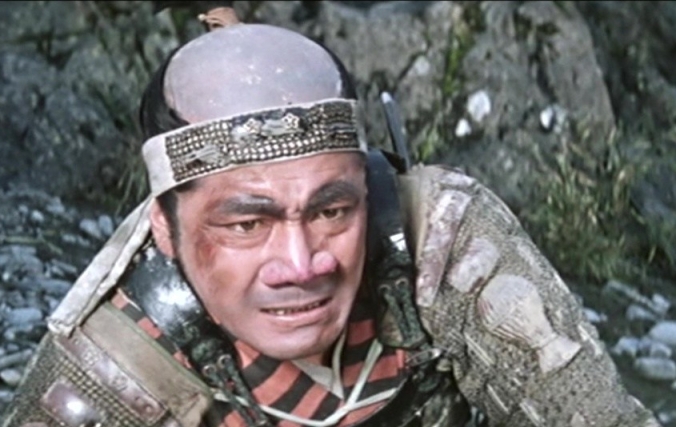 Though Japan had a rich literary and dramatic history on which to call for its movies, it occasionally looked outward to European sources such as Shakespeare. Every serious fan of course knows Throne of Blood, and I have posted about a very honorable and faithful version of Hamlet, but Samurai Saga, as it is known in America, looked beyond Shakespeare to Cyrano de Bergerac. The result is spectacularly effective, arguably the finest film adaptation of the play available.*
Though Japan had a rich literary and dramatic history on which to call for its movies, it occasionally looked outward to European sources such as Shakespeare. Every serious fan of course knows Throne of Blood, and I have posted about a very honorable and faithful version of Hamlet, but Samurai Saga, as it is known in America, looked beyond Shakespeare to Cyrano de Bergerac. The result is spectacularly effective, arguably the finest film adaptation of the play available.*
Cyrano is one of the great larger-than-life characters of dramatic history, and there was no actor more larger-than-life than Toshiro Mifune, so the pairing here is spectacularly satisfying. (For simplicity’s sake, I’ll use the familiar names of the original, though of course they all have Japanese names and Japanese settings). Mifune more than answers the call, with one of his most emotionally varied performances. His smile at his death when Roxanne recognizes him at last is an expression I don’t think I’ve ever seen him have in any other film, and that moment alone would make the movie special. But his agony, hope, and desperation in the balcony scene is as good and as heartfelt as I’ve ever seen on stage or screen, and of course the master swordsman and story-teller parts of the character are right in his wheel-house.
The adaptation is remarkably faithful, at least in incident and content; I can’t begin to guess how close the Japanese is to the original French. We see the duel at the theater in which Cyrano improvises a poem during his duel, his agony when Roxanne asks him to protect Christian, the rescue of his friend on the bridge and Christian’s interruptions of his narration of it, the balcony scene in which Cyrano feeds lines to Christian and then takes over, the battle in which Christian is killed, and finally Cyrano’s death at Roxanne’s temple where she has become a nun. All of this works so well in a Japanese setting that you would think it was a Japanese original, as well as wonder why no one thought of doing it earlier.
Of course, the first question on anyone’s mind is, “What did they do about the nose?” As you can see from the screen captures, they chose to make the nose wider, not longer. The effect is not only somewhat more plausible than the Pinocchio putty noses of stage versions, but it also at times makes Mifune almost unrecognizable. And the Japanese hat that looks like a wastebasket allows him to walk around town without constant ridicule.
As we would expect in an Inagaki movie, the fights, the crowd scenes, and the battles are handled with skill, but he also has a strong sense of just how far he can let Mifune go and no farther. Despite his reputation as a chanbara director, he seems to understand that this is really a story about three people and never lets the fight scenes run on purely for the purpose of spectacle.
I first saw this movie in the early eighties, when I had seen perhaps 20 Japanese movies at most. I found it an exotic and fascinating transferal of the Rostand play and then thought no more about it. Now that I have seen hundreds of Japanese movies, I can think of it in a different way, as a genuine oddity. Cyrano is the ultimate romantic outsider, a thoroughly independent being. As a soldier, he of course fights where told to fight, but there is no dedication to his unit, no one-for-all and all-for-one of the Three Musketeers. His looks and his sword skill combine to make him utterly and completely his own man. Within the samurai culture, that was all but inconceivable, for everyone in effect belonged to someone else. After the ronin began to appear, there were loners, but on film the ronin who weren’t seeking a new clan or new master were pretty sparse. By setting the movie around the battle of Sekigahara in 1600, even the ronin variable is removed. To Euro/American eyes, the poet-swordsman, the duels and derring-do, the exotic colorful costumes and settings, and the impossible love all seem a perfect fit for a Japanese setting. What doesn’t fit is the Cyrano character himself.
Cyrano is the world’s greatest dramatic romance, in both senses of the term. In admittedly generalized terms, Japan and in particular their movies, were about the least romantic culture in the world, also in both senses of the term. That Inagaki (credited as the adaptor/screenwriter as well as director) and Mifune managed to pull it off so well is a small miracle. Even if you have never seen or heard of Cyrano, this is an excellent entertainment, but if you know and like Cyrano, this is as good as it gets in terms of film adaptations.
* The 1950 film with Jose Ferrer is the definition of stodgy, while Rappeneau’s 1990 version is visually splendid, but somehow Gerard Depardieu misses something in the character, at least to my eyes, and I longed for Daniel Auteuil. Fine versions made from stage performances can be found by digging on YouTube or in VHS bins, but despite their fine central performances, they are videos of stage productions, not movies.
Pingback: Things We Don’t See (II) | Japanonfilm
Pingback: Kojiro / Sasaki Kojiro (1967) | Japanonfilm
Pingback: Toshiro Mifune | Japanonfilm
Pingback: Saga of the Vagabonds / Sengoku gunto-den (1959) | Japanonfilm